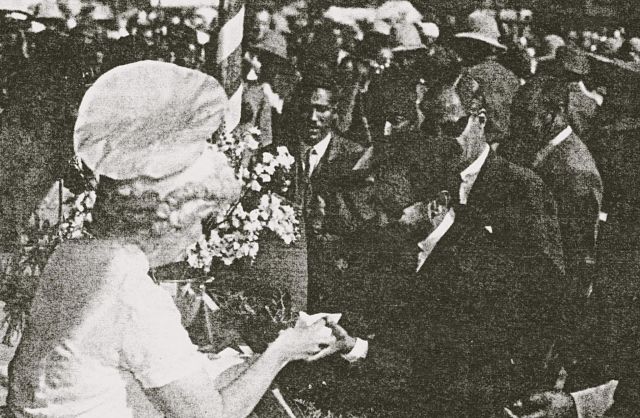 Gladys Fellows serves Emperor Haile Selassie a hamburger during a fundraiser for the Red Cross in Addis Ababa in May 1953. (Courtesy Kristin Fellows)
Gladys Fellows serves Emperor Haile Selassie a hamburger during a fundraiser for the Red Cross in Addis Ababa in May 1953. (Courtesy Kristin Fellows)
Tadias Magazine
BY Tadias Staff
Published: Wednesday, January 6th, 2016
New York (TADIAS) — The Red Moon Letters is a new photojournalism book project on Ethiopia by documentary filmmaker Kristin Fellows. The book, which is currently being released via weekly online installments, is based on a collection of letters that the author’s grandmother, Gladys Fellows, wrote when she resided in Ethiopia between 1947-1954.
Gladys’ husband, Perry Fellows, had been appointed to serve as Economic and Industrial Advisor to Emperor Haile Selassie following the end of World War II and Italy’s defeat in Ethiopia. Perry and Gladys Fellows relocated from Washington, D.C. to Addis Ababa in 1947 at the request of Ethiopian Economist Yilma Deressa — who was then Ethiopia’s Vice Finance Minister and later Minister of Foreign Affairs and Ambassador to the United States.
Prior to becoming Emperor Haile Selassie’s advisor Perry Fellows was Chief Engineer for public works administration in the United States during a time when the nation was just coming out of the depression era in the 1930s. “He was in charge of a national system that built roads and bridges to help develop the country’s infrastructure and give people jobs at the same time,” Kristin told Tadias. “He oversaw more than 5,000 projects. It was a jobs program for the public interest. A lot of our infrastructure dates back to that time.”
In the introduction to The Red Moon Letters Ethiopian historian Dr. Bahru Zewde notes that the first official contacts between Ethiopia and the United States during this period were made in 1943 during Yilma Deressa’s visit to the United States. “The U.S. response,” Zewde writes, “came in the form of an extension of their Lend-Lease to Ethiopia and the sending of a technical mission in May 1944. The latter, known as the Fellows Mission, could be said to have laid the groundwork for the subsequent American involvement in Ethiopia.”
“The Fellows Mission was named for Perry (my grandfather) who headed up the project.” Kristin states. “Pleased with the Technical Mission’s evaluation of his country’s industrial and economic prospects, Haile Selassie directed his Minister of Foreign Affairs & Ambassador to the United States, Yilma Deressa, to court Perry, and offer him a position as the Emperor’s Director of Industry and Economic Planning in April 1947.” The report prepared by Mr. Fellows was subsequently published by the Ethiopian Chamber of Commerce. While in Ethiopia Mr. Fellows also served as Chairman of the Board at Ethiopian Airlines in its early years. The Fellows also sponsored the education of over 30 children during their 7 year stay.
Kristin first visited Ethiopia when she was 11 years old. She returned in 2008 when preparing to write about her grandmother’s letters. More than sixty years after her grandparent’s trip Kristin now shares the insights gleaned from their experience in Addis Ababa during this post WWII era of renewal and reconstruction. Through weekly letters diligently written every week to her eldest son — Kristen’s father — Gladys captured both palace life as well as everyday adventures as residents of Addis Ababa.
“It’s been 12 years since I first started working on this book,” Kristin tells Tadias. “And instead of waiting to publish after completion, I have decided to post installations on my blog on a weekly basis and look forward to receiving feedback from readers in the process.” Kristin plans to publish the entire content as a book in the near future. In the process of conducting research for the book Kristin has also shared the work with historians Dr. Bahru Zewde and Dr. Richard Pankhurst.
As for the title of the book, Kristin named it The Red Moon Letters after reading about an incident described in one of Gladys’ letters. One evening in 1953 her grandparents had been woken up in the middle of the night with the house staff banging on their windows and motioning for them to come outside. Quite startled the couple did not know why the house staff was upset. The staff pointed to the night sky and the presence of a red moon, demanding why it was red. Gladys tried to muster up a scientific explanation in the limited Amharic she had learned, but the staff would have none of the explanation. Instead they told Gladys and Perry that the last time there was a red moon in the sky was the night before the Italian invasion, and they wanted to know if this was a bad omen and if they should head to church to pray the entire next day. “It was a significant story,” said Kristin, because it made her realize why her grandparents traveled all the way to Ethiopia in the first place: to assist in uplifting the country following the Italian invasion during World War II.
“My grandfather loved Ethiopia, and he was very meticulous about his work,” Kristin says. And as a result her family now has a deep connection to the country, people and cultures. The Red Moon Letters is a personal attempt to share the Fellows’ everyday experience in Ethiopia during this unique time, and to provide an alternate view of the era.
Below is a chapter from The Red Moon Letters posted on January 5th, which provides a backstory of how Perry Fellows came to serve as one of the Emperor’s advisors.
http://theredmoonletters.com/2016/01/05/3/
and here is an excerpt of one of Gladys’ letters that the book is based upon:
Addis Ababa, Ethiopia
16 February 1953
I was awakened at 3 am last night by a knock on our bedroom window. Thinking one of the guards had bumped into it accidentally, I didn’t respond. But almost at once it came again so I called out, “What do you want?” In urgent tones the guards whispered they needed to speak to Perry.
Worried there might be thieves, I woke him up immediately and the two of us rushed out into the freezing cold night wearing nothing but our old, thin p.j.’s.
There we found the guards, neither of whom speak any English, anxiously beating their heads with their hands. They practically pushed Perry around to the back of the house and pointed up at the moon, which was a startling red. I have never seen anything like it before.
Perry spent much of the following hour trying to calm them down with assurances that everything was all right, but they were not so easily satisfied.
When the cook came in this morning, I asked him why the guards had been so frightened. He told me the only other time Ethiopians had ever seen a red moon was the night the Italians came. I tried to explain to him that it was probably just some atmospheric condition – a little hard with my limited Amharic and his limited English. And though he is smart and rather modern in his thinking, I could see he was still concerned. He said the old men would not believe it after all they had suffered.
When Adamaso came to work, he too was very unhappy, as he is one of the older ones here. The guards wanted to know if they should go to church and pray all day.
—
Related:
Have You Seen Ethiopia AD in the New York Times Lately?
Join the conversation on Twitter and Facebook.

























